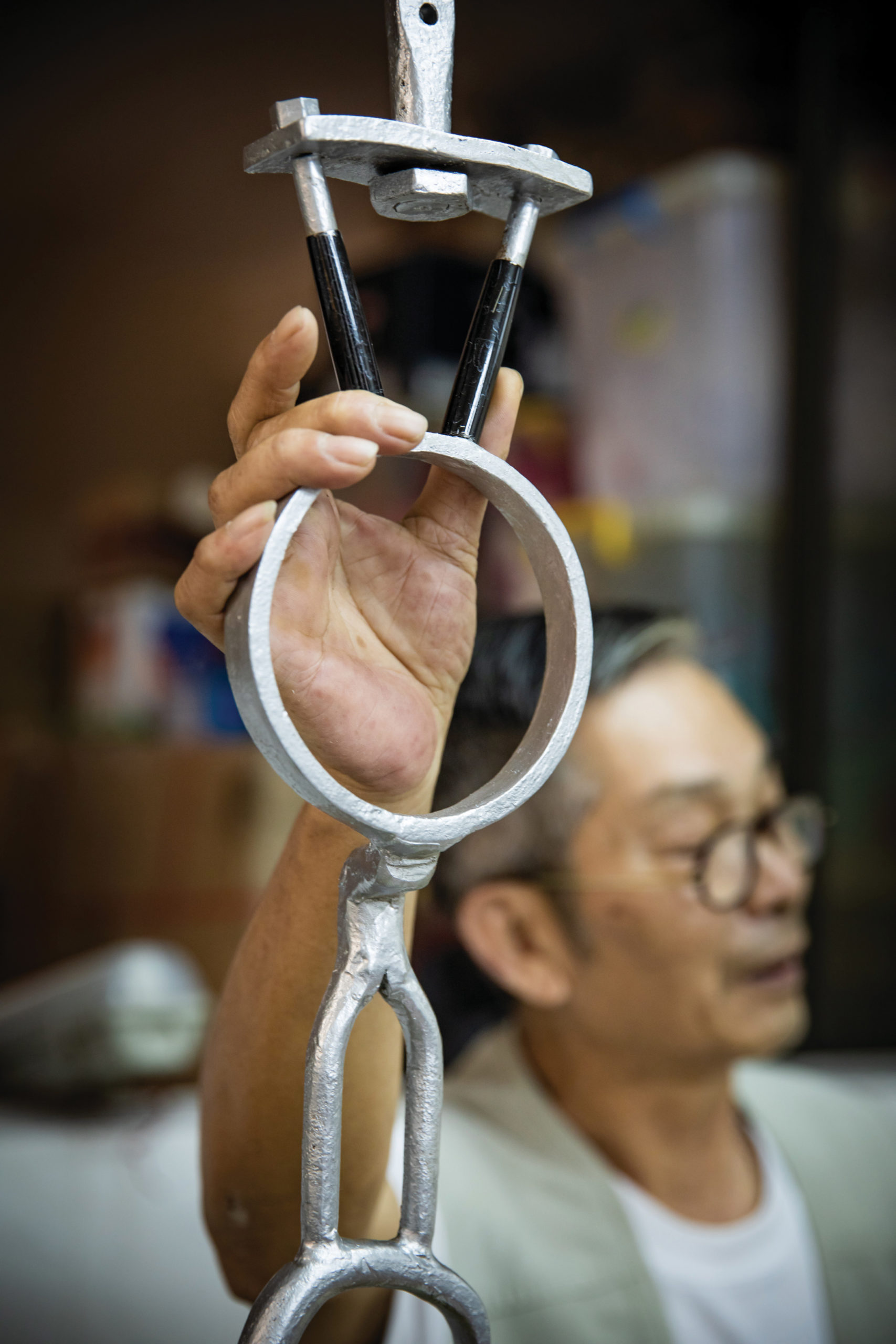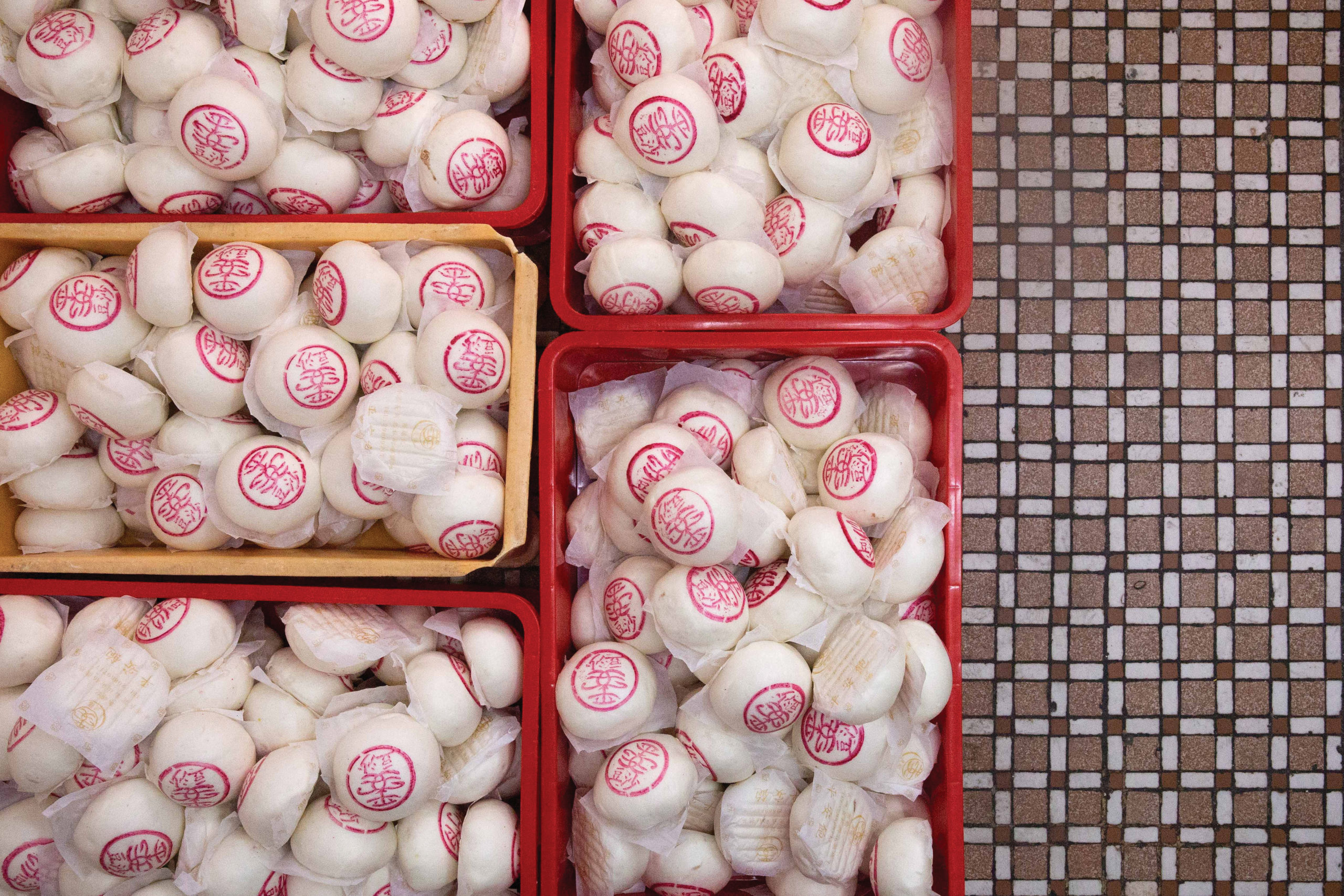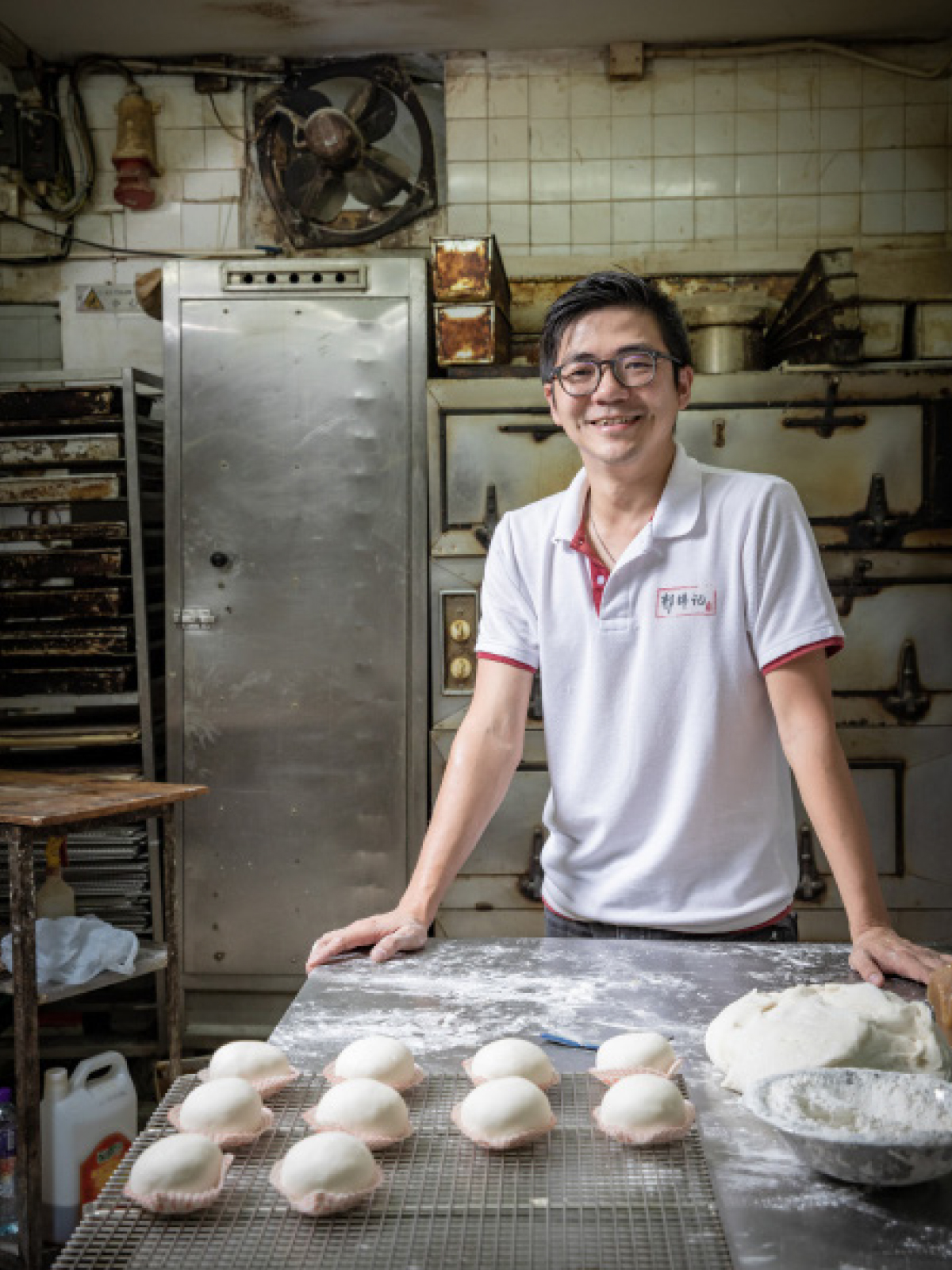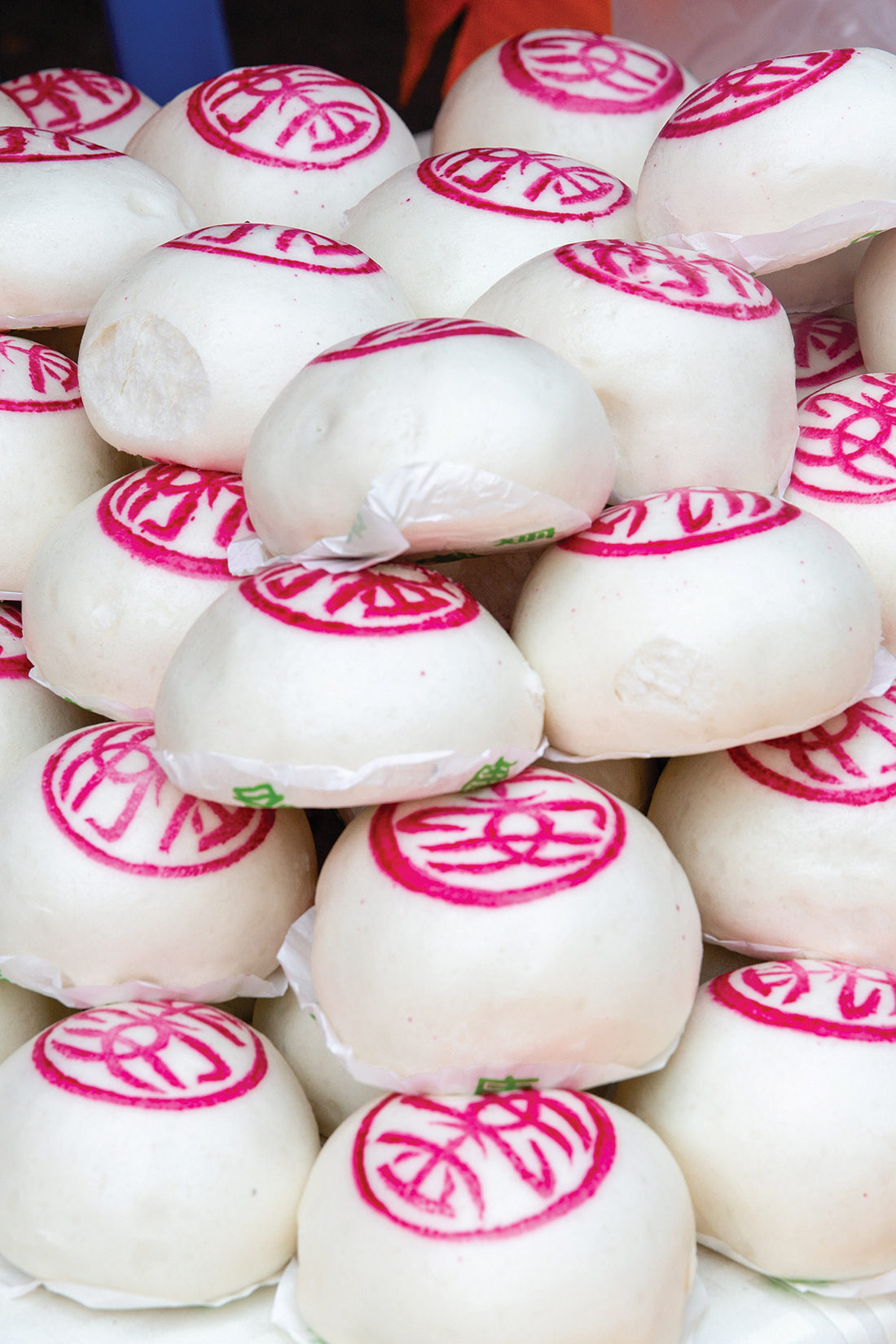Every May, coinciding with Buddha’s Birthday in the fourth Lunar month, all eyes are on the massive Cheung Chau Jiao Festival. Tens of thousands of tourists and Cheung Chau islanders come to watch and participate in this lively and colourful traditional celebration, whose highlights are the Piu Sik (Floating Colours) Parade and the Bun Scrambling Competition. Beautifully-designed floats wind along the designated route on the island of Cheung Chau, while the Bun Scrambling Competition which takes place at midnight leaves audiences in awe, as athletes scale 14-meter “bun towers”, competing to grab the most lucky buns from the top of the tower. The Festival spells life to the people of Cheung Chau. Young and old alike are eager to play their part, make their mark and pass on the beautiful traditions of the Festival. This year, we talked with senior members of the “Cheung Chau Pak She Street Association”, who have been behind the staging of the Floating Colours Parade for many years. We also spoke to the second generation family owners of the Kwok Kam Kee lucky buns store, about their Cheung Chau memories – and how they pass on the spirit of the Festival…
In 2011, the Festival was
included in the third national list of
intangible cultural heritage.

Origins of the Festival
The Cheung Chau Jiao Festival, is a Taoist memorial ceremony that is actually not unique to Cheung Chau. However, due to the special rituals of the festival in Cheung Chau, and the fact that (unlike many similar events elsewhere) it is organised every year, it has become the most famous activity of its kind in Hong Kong and Guangdong. In 2011, the Festival was included in the third national list of intangible cultural heritage, bestowing formal recognition for its huge cultural significance.
There are many versions of the legend behind the Festival; but the most widely-accepted one is that Cheung Chau was devastated by a plague in the late Qing dynasty. To drive away the veil spirits, the locals set up a sacrificial altar in front of the Pak Tai Temple to pray to their deities and to bring comfort to the departed souls from the land and the sea.
The residents also paraded deity statues along the village lanes. Their prayers were answered: the plague ceased immediately. Since that day, Cheung Chau residents have held the annual Jiao Festival to express their gratitude to Pak Tai for blessing the area with good health and peace.
Historically, the dates of the Festival were not fixed: residents had to ask Pak Tai which day after the Mid-Autumn Festival was deemed most propitious. Since the reunification of Hong Kong with China, the Buddha’s Birthday has been fixed as the 8th day of the fourth lunar month. With the approval of the gods, it was agreed that the Festival would be organised to fall during the Buddha’s Birthday holiday. As a result, visitors from Hong Kong and elsewhere can now enjoy a day off and participate in this yearly festive event in Cheung Chau.

Floating Colours Parade
Designers of the Floating Colours Parade
The Floating Colours Parade is a major element of the Jiao Festival. On the day of the Buddha’s Birthday, hand-crafted floats carry children dressed as various well-known characters – such as “Monkey King” (or Sun Wukong), the protagonist of the novel Journey to the West. In recent years, children have also been dressed as public figures or characters in TV dramas. The parade tours the island, accompanied by lion dancers and Qilins (mythical hooved chimerical creature known in Chinese and other East Asian cultures). Brothers Ching Yat Ming and Ching Yat Fan of the Cheung Chau Pak She Street Association, as well as its current chairman Leung Yung Kan, are living encyclopaedias of Cheung Chau and the traditions of its Floating Colours Parade. They have many stories to tell of taking part in the parades when they were young, and planning and designing floats when they were older.
For them and other senior inhabitants of Cheung Chau, the Jiao Festival is the biggest event in the island’s calendar: “If you want to reunite with old friends who have left Cheung Chau for some time, pick the day of the Jiao Festival! Cheung Chau islanders love to come back for the celebrations during this Festival. I would say the festive atmosphere is even stronger than at the Lunar New Year,” says Ching Yat Ming.
Casting for the Parade: Who to Choose as Performers?
Every year before the start of the Festival, the children were usually so excited they would stay up all night. “There used to be less entertainment in those days, so the children were all very happy whenever there were celebrations,” Yat Ming continues. The Cheung Chau Kwok Man School, where the Ching brothers studied, would be closed a few days before the Festival and become temporary sleeping quarters for the Police officers who were on duty during the Festival. On the day of the Festival itself, as soon as the children woke, they would rush to the Association’s centre to watch the preparations. Of course, if a child was fortunate enough to be selected as a performer, parading on a Float, so much the better.
Ching Yat Fan was selected as one such performer for many years. Later, his son also shared the same honour, being chosen more than ten times during his childhood. “Children who look chubby and cute are likely to be chosen,” explains Yat Fan. Yat Ming and Leung Yung Kan add jokingly that they have been unsuccessful for many years, and still feel bitter to this day! “Nonetheless, it was also fun and joyful being able to participate in the parade as flag bearers,” adds Yat Ming.
Nowadays, although there are fewer and fewer young islanders in Cheung Chau, casting for the parade is still fun. “A few years ago, we would have to wait in front of kindergartens and approach parents once we spotted suitable kids. Now it’s more convenient: we contact kindergartens on the island and set up official casting sessions. And we get the children to try sitting on the floats, to see if they are afraid.”


“The design of the rod requires more thought and skill, and is often more complicated than the costumes and styling.”
Every Float is a Work of Art
We naturally notice the cute characters portrayed by the children during the Floating Colours Parade, but the design and structure of the float itself is also often a focal point. A float is really just a means of transporting two children during the Parade: one child stands on foot supports mounted on a rod, above another child. The rod connects the two children, but it’s more than just a functional support apparatus:
“The design of the rod requires more thought and skill, and is often more complicated than the costumes and styling,” explains Yat Ming. During the parade, the rods are decorated with interesting and eye-catching ornamentation that explains the theme of that particular float. In the old building of the Cheung Chau Pak She Street Association, more than 40 different rods have been designed over the years.
In other words, if there isn’t an intricate rod it is not possible to illustrate the theme with fun designs. “Since forging is very complicated, we will first make a model out of thin wire, then we talk to the blacksmith about our ideas,” says Yat Ming, who was clearly proud of the work of the Association. “There was once a great blacksmith in our Association, and he lived just opposite our centre. No matter how tricky the theme was, he always found a way to illustrate it.”
“Every association wanted their own designs to wow the spectators, so everyone kept their ideas secret until the night before the Parade.”
From Traditional Stories to World Events
One year, the theme of the float was the Jin Yong novel Sword Stained with Royal Blood (which was adapted into a TV drama that became very popular in Hong Kong). The story features a twisted, snake-like “Golden Serpent Sword”; “So we asked our blacksmith to forge a snake-shaped rod,” continues Yat Ming. “We wanted to make it even more lively, so we invited someone who makes animal models to give us a snake skin to cover the rod.
“The main character of that year was of course the protagonist of the story ‘Jinshe Langjun’. The theme of that float was so vividly illustrated that people are still talking about it today! There was another year when the theme was the Cantonese film Third Master Sha and Lady Ngan.
We installed a small teapot and an artificial bird (note: drinking tea while bird watching is a traditional pastime of rich Chinese families), reflecting the spoiled personality of the protagonist Third Master Sha. The accessories were all very intricate. We had to be very careful when drilling holes in the small pot before it was fixed onto the rod. If it was not done carefully, the porcelain would be broken – and we would need to start all over again!”
Since the design of the floats reflect the creativity and dedication of its community, each group attaches great importance to it: “We used to be more nervous in the past,” adds Leung Yung Kan. “Every association wanted their own designs to wow the spectators, so everyone kept their ideas secret until the night before the Parade.
But now it is not so serious; it is an island-wide celebration so nobody minds letting others know what their designs are.” In fact, these days, everyone usually starts brainstorming themes for the upcoming parade as early as the Lunar New Year. There were no TV dramas and mass media decades ago, so themes were based on folklore. In later years, they have often found inspiration in popular TV dramas, and even current affairs and public figures from around the world.
Regardless of the style and subject matter, you can be sure that the characters portrayed by the children in the Floating Colours Parade will give tourists lots to look at and enjoy.
Lucky Buns

Blessings from Cheung Chau
Martin had a dream: to use his knowledge to promote the craftsmanship and tradition of Cheung Chau through the Kwok Kam Kee lucky bun store which his father had founded. So a few years ago he decided to quit his secure, well-paid job as general manager of a listed company. Now, as the second generation of his family to run the store, Martin tells us his own, unique story of lucky buns:
I’m a Cheung Chau Person, Not a Central Person
Martin, in his thirties, wears glasses and an open-necked shirt. Talking about his plans to expand Kwok Kam Kee, his business strategies, corporate responsibility, and last year’s partnership with a cartoon brand, he looks more like a big city businessman than a native of Cheung Chau. But, once he steps into the workshop, he is transformed into a proper pastry chef as he grabs the dough in one hand, while sprinkling yeast and adding in lotus fillings with the other.

“There are not many places in Cheung Chau that make lucky buns, so we often have to produce more than 70,000 buns within the two weeks of the Jiao Festival.”
Either way, Martin is a true native of Cheung Chau. After graduating from university, he joined the business world and worked in offices in Central, but he never moved out of Cheung Chau. “It only takes half an hour to get to Central by ferry. Cheung Chau is really not as remote as everyone thinks.” When Martin was young and had nothing to do after class, he would always go back to Kwok Kam Kee and watch how his Dad and other chefs made buns.
The “lucky buns” are always the main focus of every Cheung Chau Jiao Festival – highlights of which are the three giant bun towers and the exhilarating Bun Scrambling Competition. It is believed that the lucky buns bring good fortune and blessings, which is why people are always so enthusiastic about climbing the tall bun towers, in the hope of grabbing the highest “holy buns”. In addition, continues Martin, “there are 36 small bun towers which are used to treat the ‘spirits’. There are not many places in Cheung Chau that make lucky buns, so we often have to produce more than 70,000 buns within the two weeks of the Jiao Festival.” Even in the years when Martin was working in the city, he would always take two weeks off to help out at the store during the Festival.
In the past, there were no safety measures in the Bun Scrambling Competition and it could get very dangerous at times. Some enthusiastic participants would even climb from the inside of the tower in order to save time, then break out at a certain height. It was not until a serious accident happened in 1978 that the government decided to stop the activity. It was eventually resumed in 2005 when it became a properly-organised competitive event, with strict security measures and clear regulations. In that first year after the competition resumed, Martin was eager to compete:
“That year, I still took time off to help out at Kwok Kam Kee. I had been busy in the store until late in the evening, and then I rushed to the competition venue at eleven o’clock. I hadn’t even trained beforehand, but I was the seventh to finish the race nonetheless. I’ve enjoyed the Jiao Festival since I was young. I still like to watch the Parade. I was never a performer at the Parade when I was young, but all of my children have had the opportunity to participate as performers.”
“I always feel that my work and business are only valuable when I can bring blessings to others.”


Lucky Buns are Blessings
Martin has never forgotten the traditions of Cheung Chau and his fond memories of Kwok Kam Kee. After spending some years working in corporates, Martin started thinking about how to carry on his father’s bakery business. “I really wanted to promote my Dad’s store. I knew he would retire soon and I couldn’t bear to see that as the end of Kwok Kam Kee.” Soon after graduation, when Martin would come home to help during the busy period around the Jiao Festival, he already sensed the importance of his family’s store to people.“A lot of familiar customers deliberately come back every year from places such as Tuen Mun, Shatin, and order buns from us for their families and friends. For the non-islanders, lucky buns are not simply a holiday delicacy or a sacrifice: they are also blessings for family and friends.”
In fact, Martin has long been influenced by his mother and understood that he must help others as best he could. In addition to giving a hand at Kwok Kam Kee, Martin also helped at the resort house run by his mother when he was young. “One winter, I went downtown with my mother to buy a new quilt and bedding for the resort house. On our way to catch the ferry, she saw a rough sleeper. She immediately stopped and gave this new friend (that she had only just met) the newly-bought quilt; then she asked me to go to buy a lunch box immediately so he could also have a good meal.
“My mother could always put aside the most urgent of matters, in order to help others. Rushing to keep to a schedule, or to catch a ferry? These were of no importance to her.” Martin has partnered with charities this year to distribute nearly 10,000 lucky buns to the elderly in town. “I really hope to pass on these blessings to other people. Perhaps affected by my mother, I always feel that my work and business are only valuable when I can bring blessings to others.”
“He hopes to promote the buns even further, based on his experience in business and his affection for Cheung Chau.”
Tradition with a new twist
For many years, tourists have embraced the meaning behind the lucky buns. When they saw chefs putting red stamps on the buns at the store, they were curious to try that themselves. In response, Martin tried ordering a batch of mobile phone accessories with small “peace” logos to be sold in the store; surprisingly, they sold fast during the Jiao Festival. Over the years, Martin has become more confident about adding modern elements to the lucky buns. He hopes to promote the buns even further, based on his experience in business and his affection for Cheung Chau.
And that’s why Martin decided to resign from his full-time job and devote his full attention to the family business. “I didn’t even inform my Dad of my resignation; he always felt that I would have a brighter future outside and that it was a waste to come home and take care of the bakery. Dad was surprised to learn about my decision, but he still supported me.”
Yet, it was not easy to return to Cheung Chau from the commercial world. First of all, Martin needed to study the recipes of the lucky buns as well as other cakes and pastries sold in the store. “When I came back to help in the past, I didn’t have to think about the ingredients, the whole operation, and so on: you just do whatever you are told. However, everything was much more serious now that I was running my own business. I burnt so many cakes at the beginning, too!”
He found that mastering the techniques in pastry making is not the most difficult task. “My wish is not just to make good lucky buns: instead, I hope to explore more partnership opportunities to achieve more exposure for Kwok Kam Kee and our products. These negotiations are often more tiring, especially when they can only be done after opening hours.” Fortunately, Martin has been making headway: last year, Kwok Kam Kee successfully partnered with a cartoon brand to launch Hello Kitty and Gudetama lucky buns. Meanwhile, other side products have also been released, such as Hello Kitty lucky buns keychains, which have proved very popular. This year, Martin worked with another cartoon brand on producing different products of Spiderman and got very positive response as well.
“I have a dream that one day, Kwok Kam Kee will become the name for lucky buns that is recognised throughout Hong Kong and even abroad. So, when it comes to lucky buns and the Bun Scrambling Competition, people will also think of Kwok Kam Kee,” Martin concludes. We are also very much looking forward to that day!

